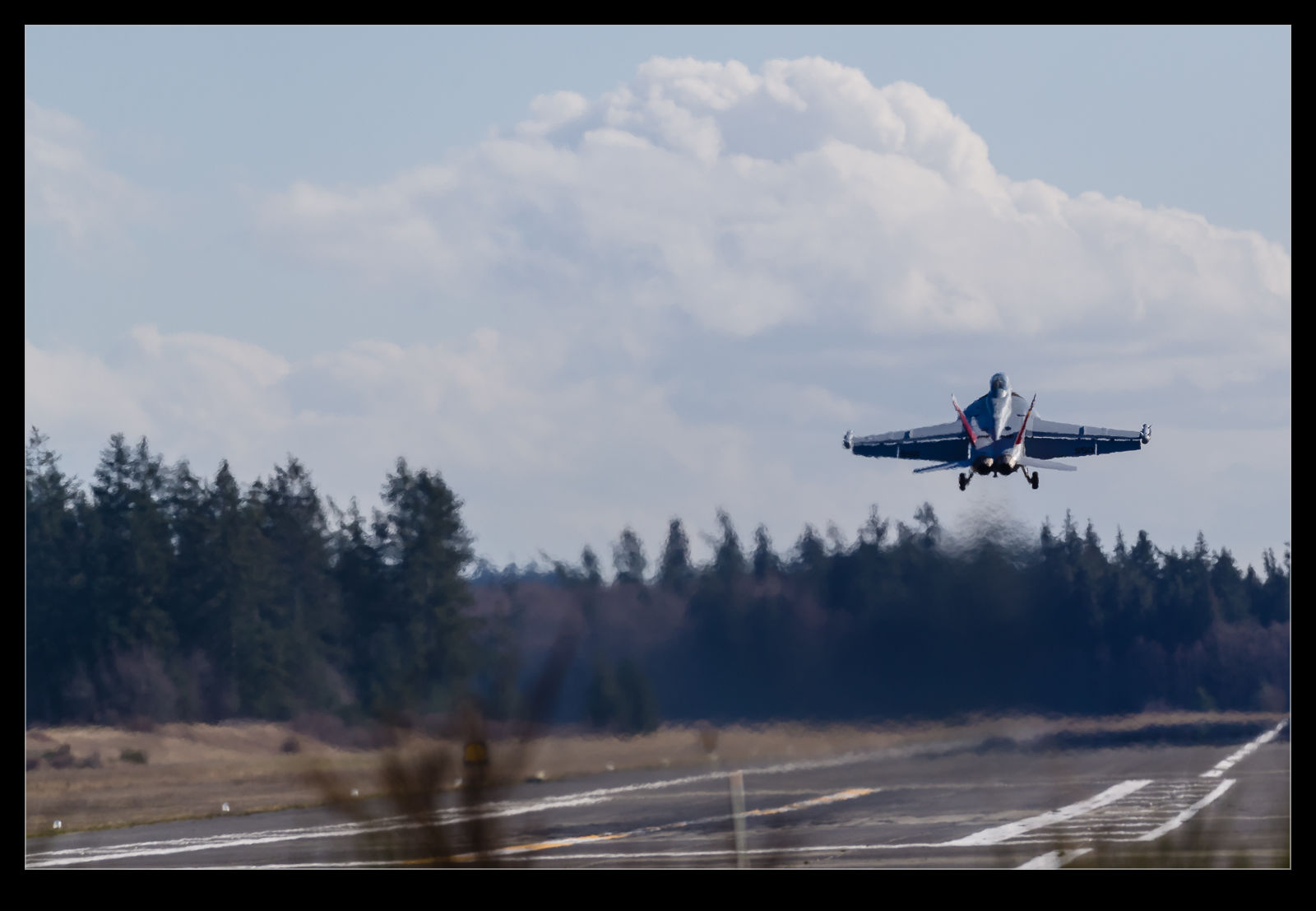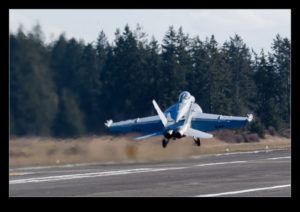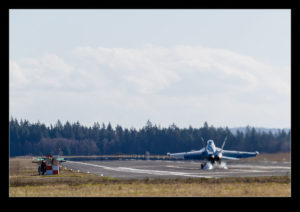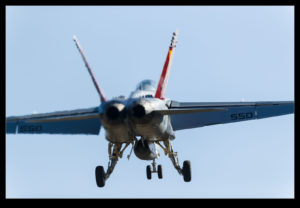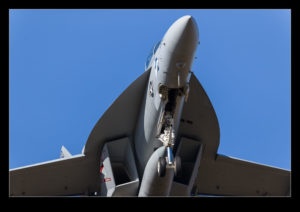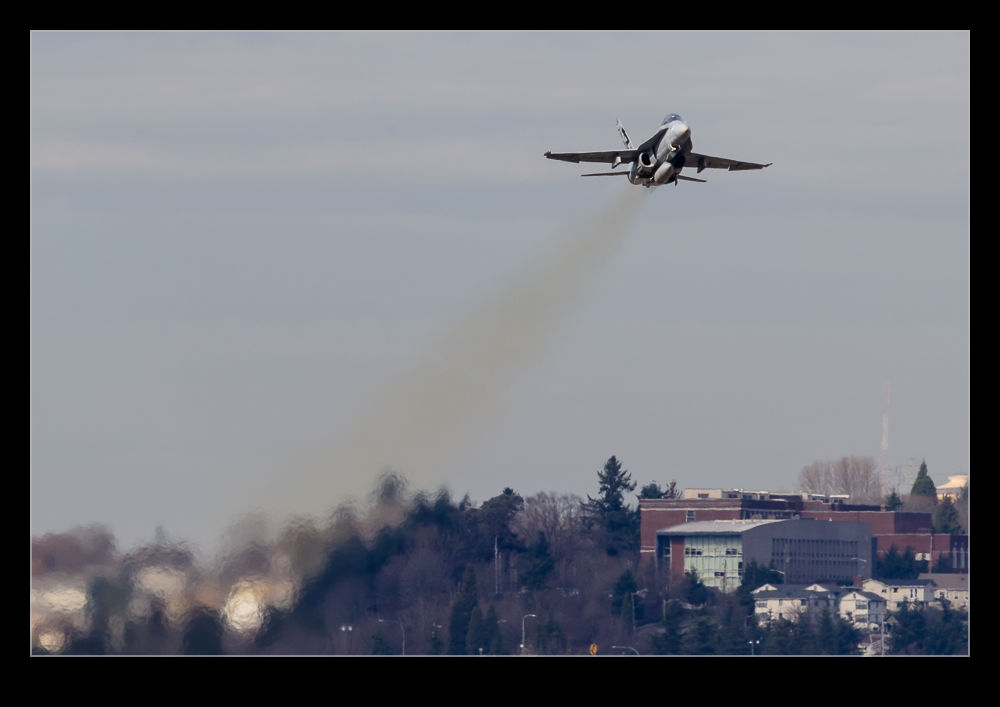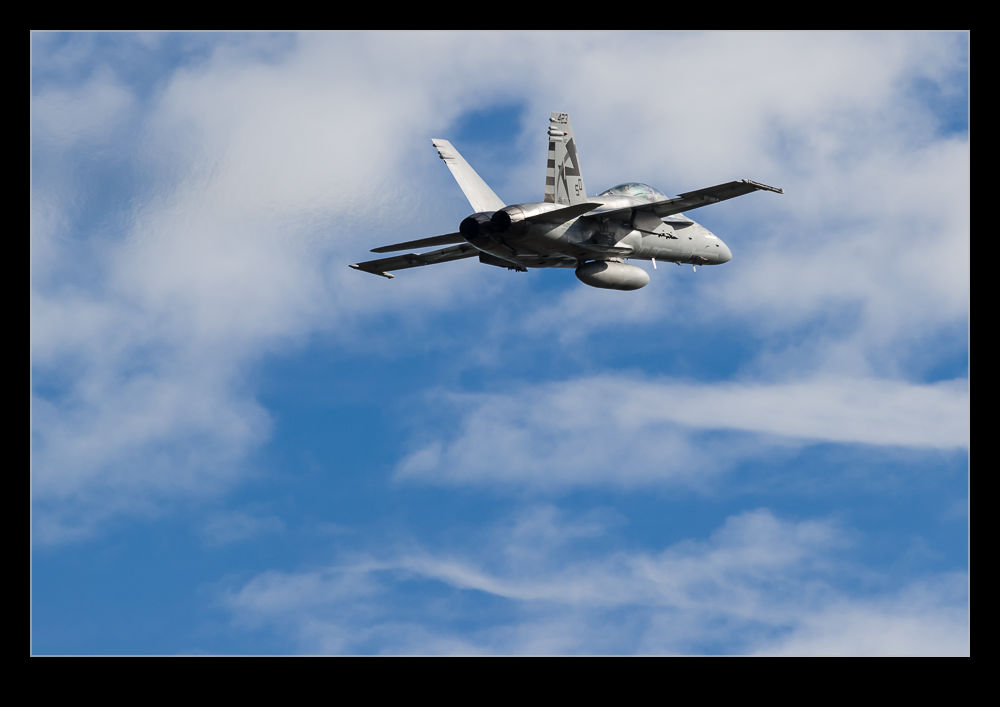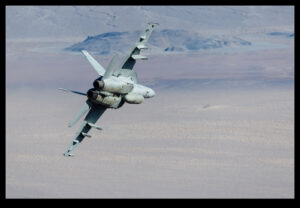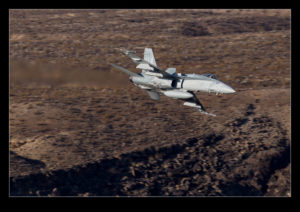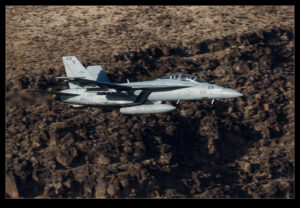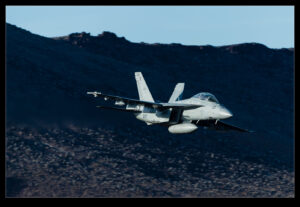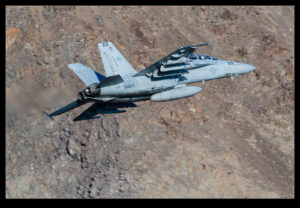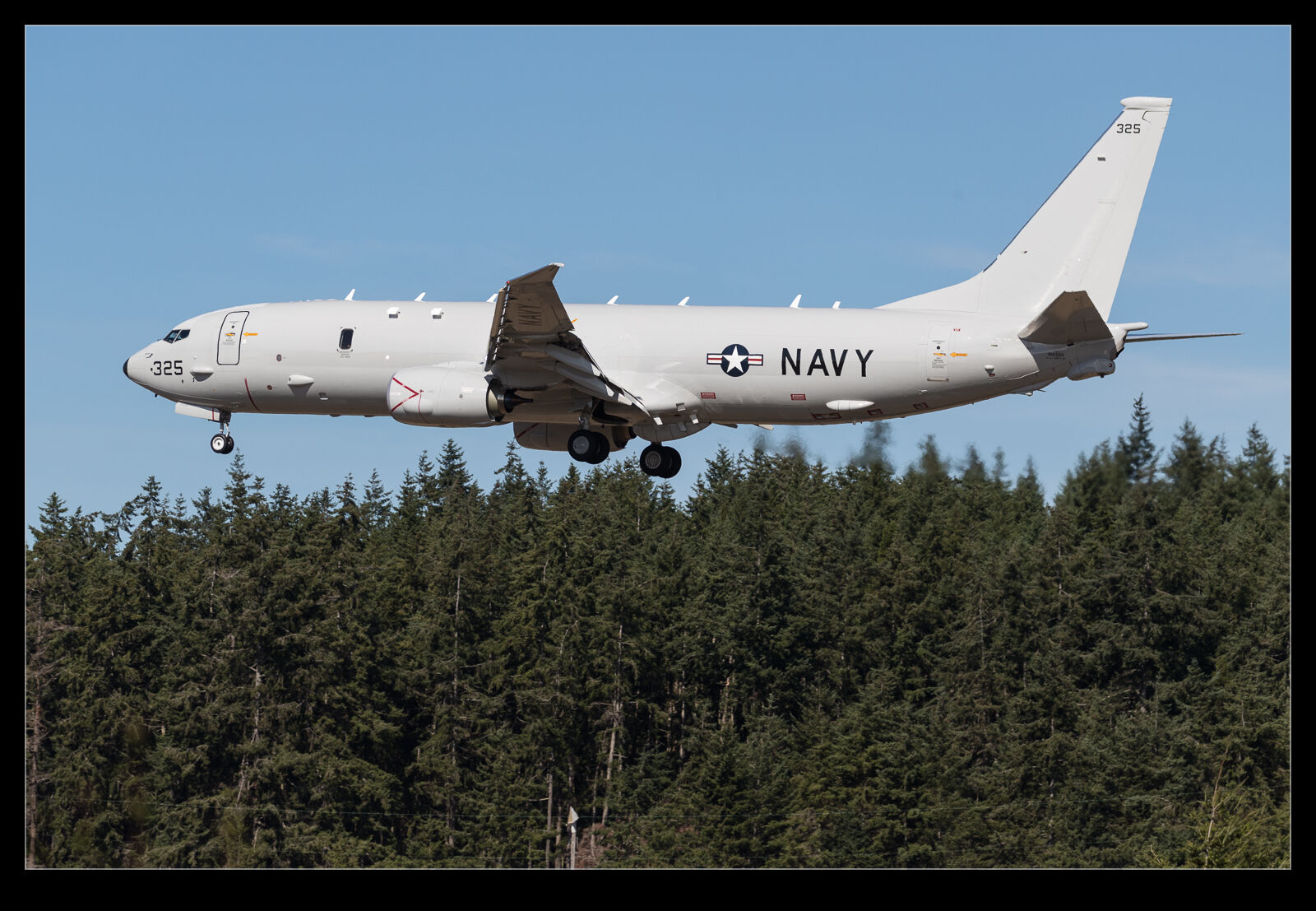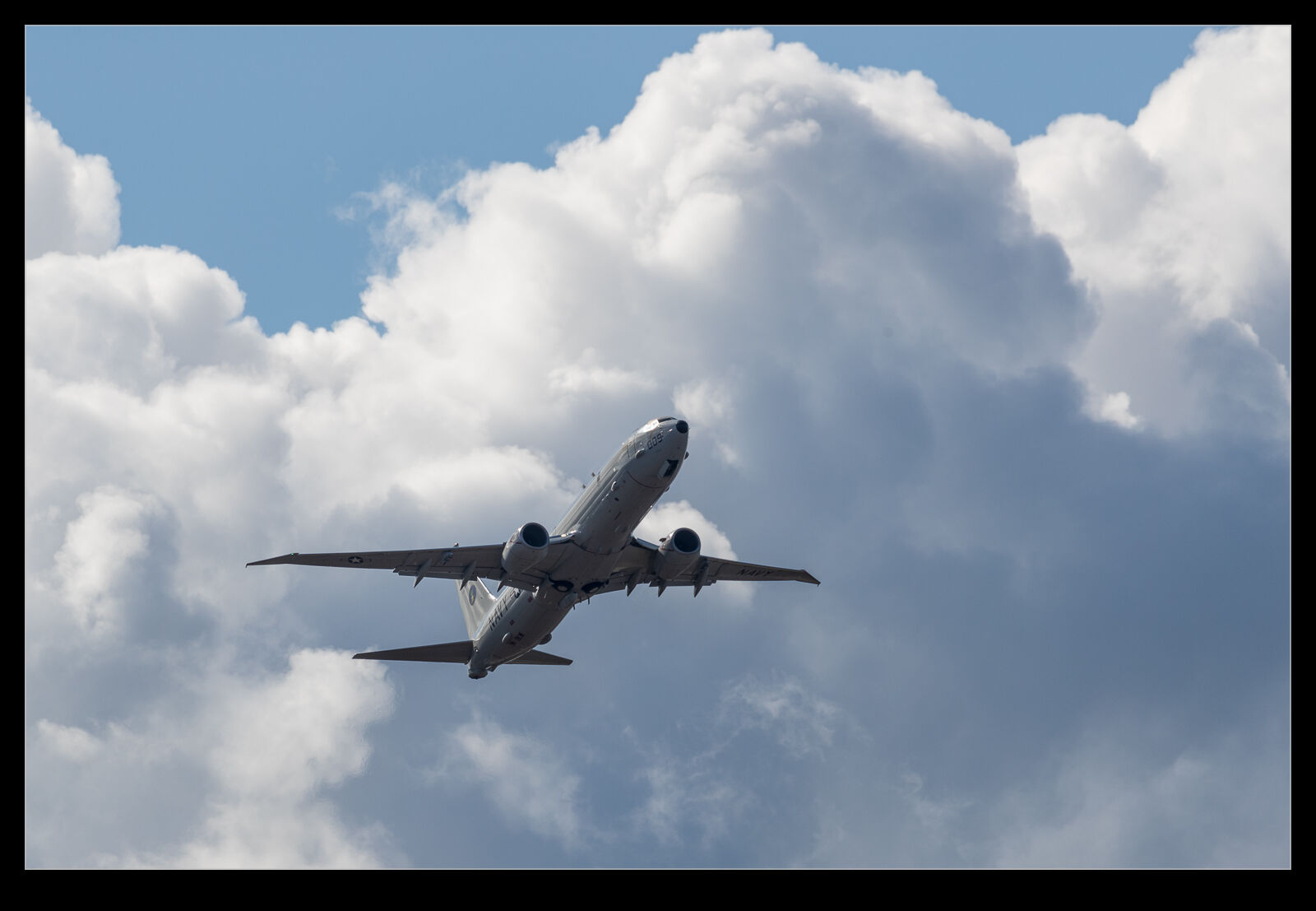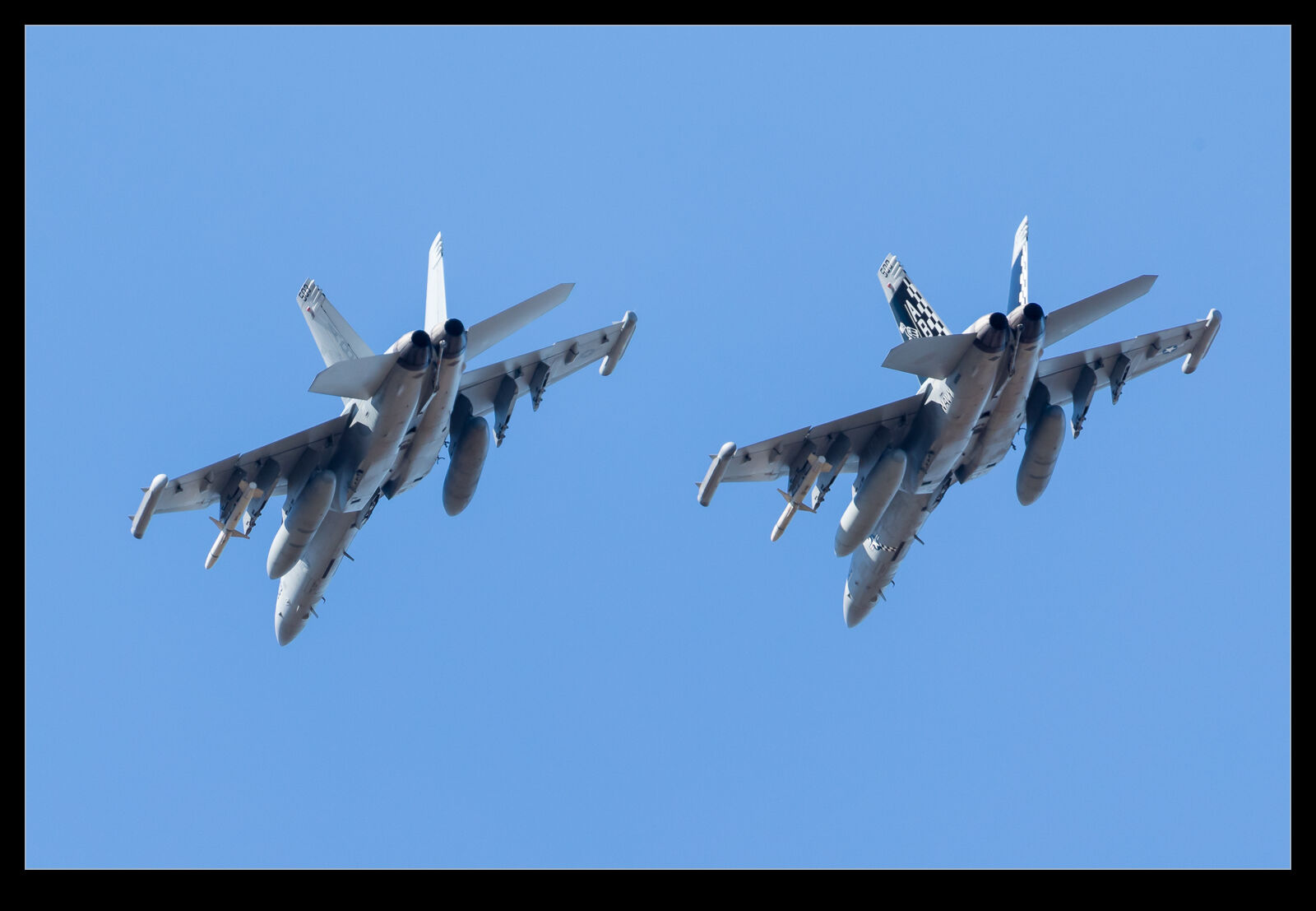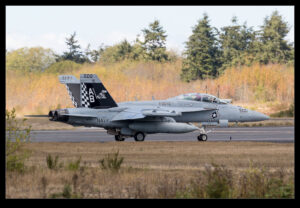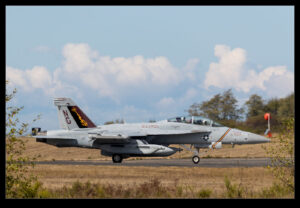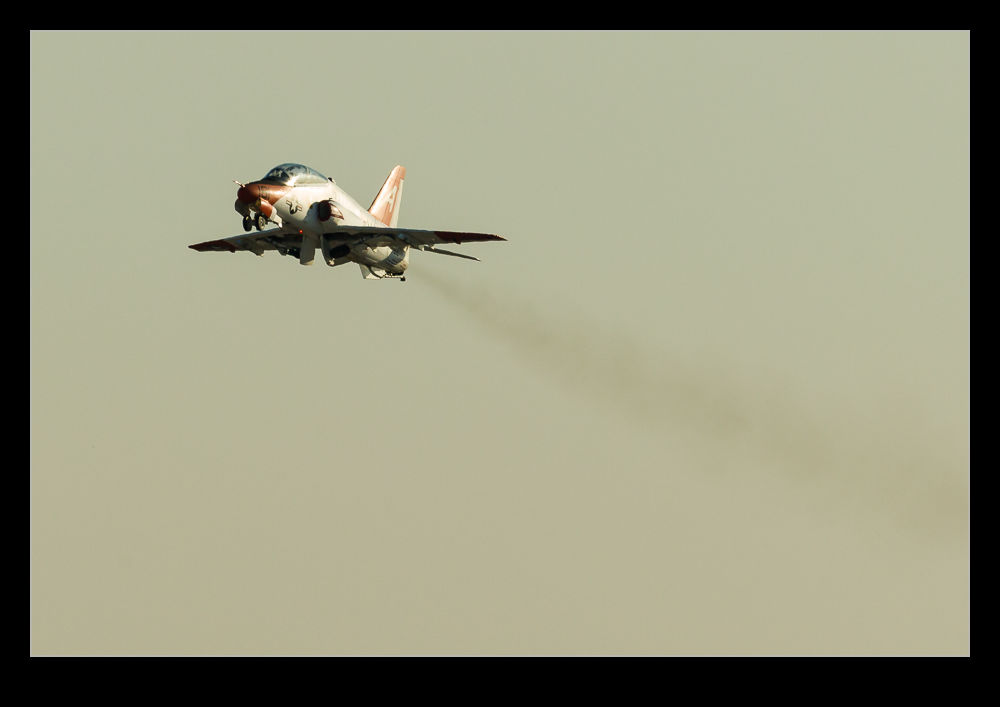 Since the Growler crews were training as if they were on the deck at sea, they don’t flare their landings at all. They hit the runway hard and the tire smoke that results is substantial. Normal landing procedure on a carrier is to go to full throttle as soon as they hit the deck. There isn’t time to react if you miss the wire so hit the gas and, if the wire doesn’t stop you, you fly right off the other end of the deck and climb away. Since there is no wire at Coupeville, that means every touchdown is followed by a rapid rotation and climb away. The climb is pretty steep initially which keeps the speed under control until the power is backed off.
Since the Growler crews were training as if they were on the deck at sea, they don’t flare their landings at all. They hit the runway hard and the tire smoke that results is substantial. Normal landing procedure on a carrier is to go to full throttle as soon as they hit the deck. There isn’t time to react if you miss the wire so hit the gas and, if the wire doesn’t stop you, you fly right off the other end of the deck and climb away. Since there is no wire at Coupeville, that means every touchdown is followed by a rapid rotation and climb away. The climb is pretty steep initially which keeps the speed under control until the power is backed off.
Tag Archives: Navy
Growler Overhead
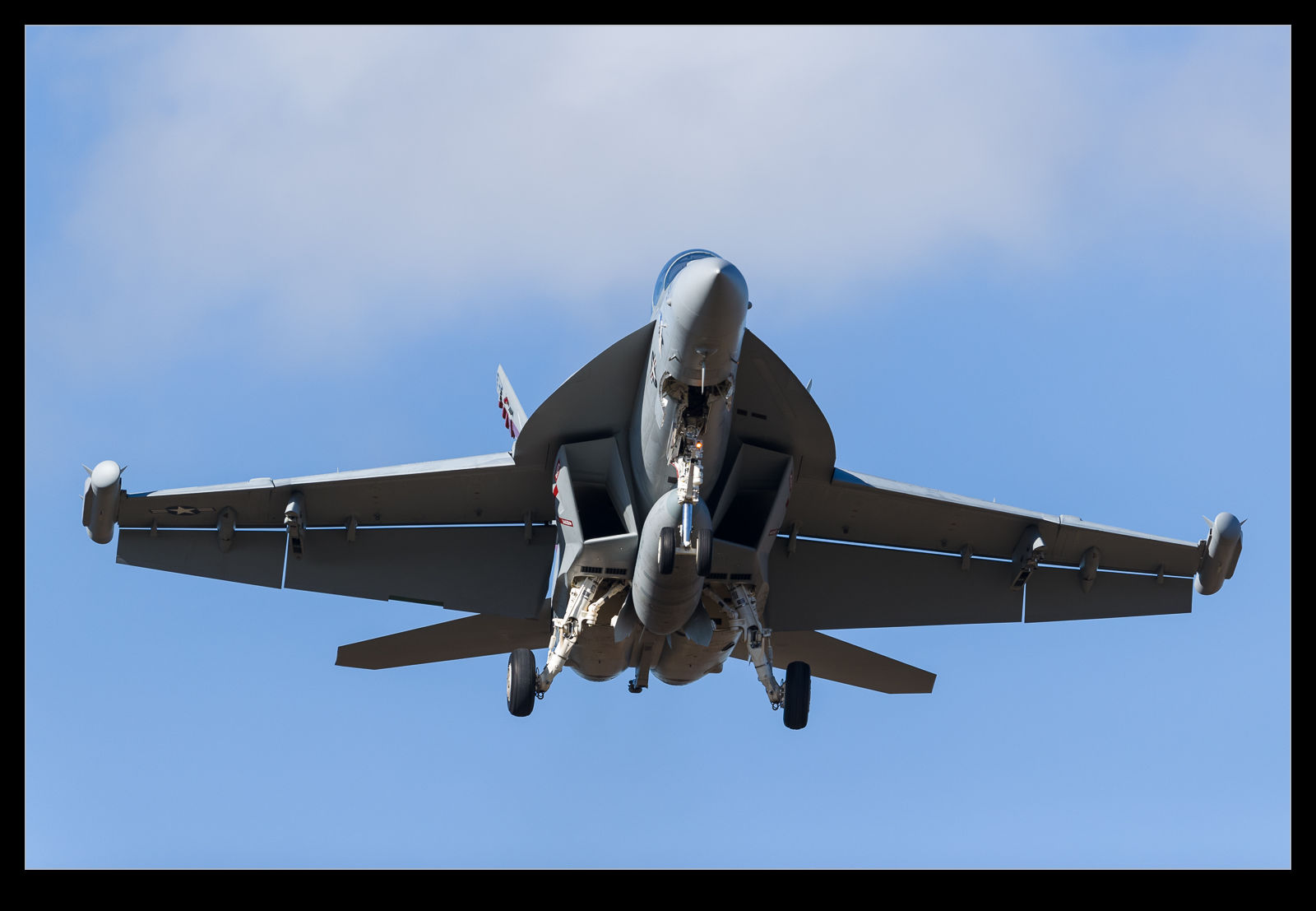 The approach to the runway at Coupeville brings the jets right over one of the local roads. This meant I had the opportunity to go for some head on type shots of the jets. As they came right over the top of me, I got a nice view of the underside of the jets. I also experienced the noise level of a Growler. I hadn’t thought to bring hearing protection and, if I go back, which I am pretty sure I shall do at some point, I will remember to take some. You are really quite close and the sound levels are high!
The approach to the runway at Coupeville brings the jets right over one of the local roads. This meant I had the opportunity to go for some head on type shots of the jets. As they came right over the top of me, I got a nice view of the underside of the jets. I also experienced the noise level of a Growler. I hadn’t thought to bring hearing protection and, if I go back, which I am pretty sure I shall do at some point, I will remember to take some. You are really quite close and the sound levels are high!
FCLP Training for the Growlers
 Naval aviators have to practice the art of landing on a carrier a lot. Before they ever go to the boat, they undertake a lot of field carrier landing practice. This involves flying the carrier pattern to a runway as if it was the boat. The outline of the deck landing area is painted on the runway, the lighting is replicated and the guidance calls are provided by crews alongside the runway just as if they were at sea. The crews fly around the pattern and thump onto the runway just like it was the deck and then apply power just like they would if they were aiming for a wire.
Naval aviators have to practice the art of landing on a carrier a lot. Before they ever go to the boat, they undertake a lot of field carrier landing practice. This involves flying the carrier pattern to a runway as if it was the boat. The outline of the deck landing area is painted on the runway, the lighting is replicated and the guidance calls are provided by crews alongside the runway just as if they were at sea. The crews fly around the pattern and thump onto the runway just like it was the deck and then apply power just like they would if they were aiming for a wire.
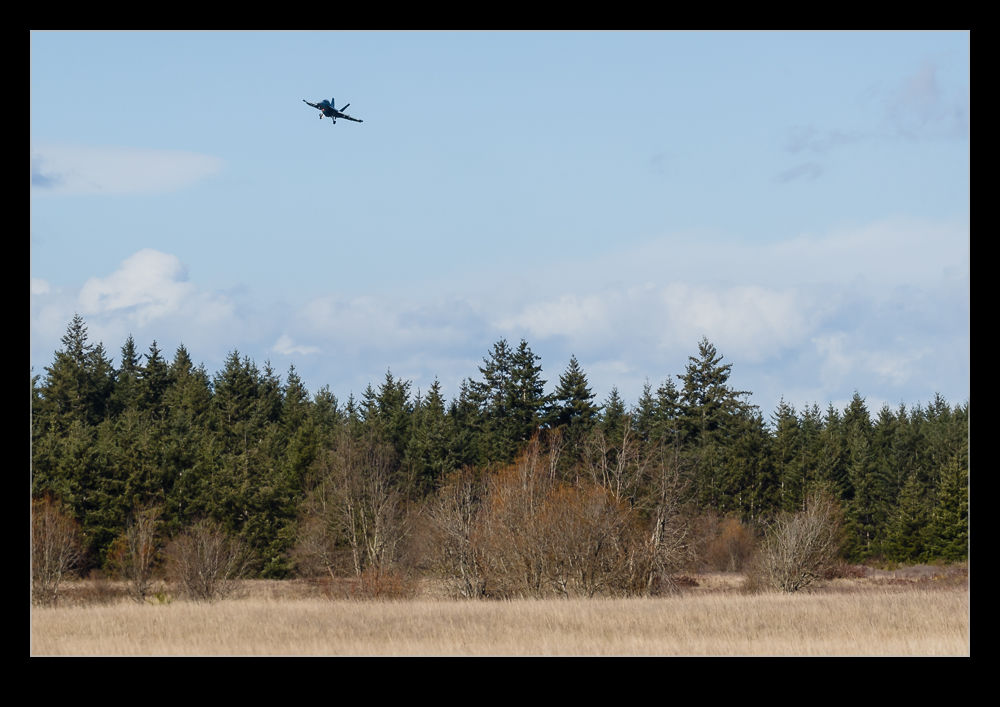 Of course, there is no wire so they power up and fly away to repeat again. The goal is to be as practiced with the whole procedure as possible before they ever go to sea. Naturally, there is still a difference dealing with a static runway in a field as opposed to a moving ship in open sea. Still, it is the way to prepare. Naval air stations tend to have separate fields away from the main base at which this training can take place. They are away from the normal base flying and allow this training to take place uninterrupted.
Of course, there is no wire so they power up and fly away to repeat again. The goal is to be as practiced with the whole procedure as possible before they ever go to sea. Naturally, there is still a difference dealing with a static runway in a field as opposed to a moving ship in open sea. Still, it is the way to prepare. Naval air stations tend to have separate fields away from the main base at which this training can take place. They are away from the normal base flying and allow this training to take place uninterrupted.
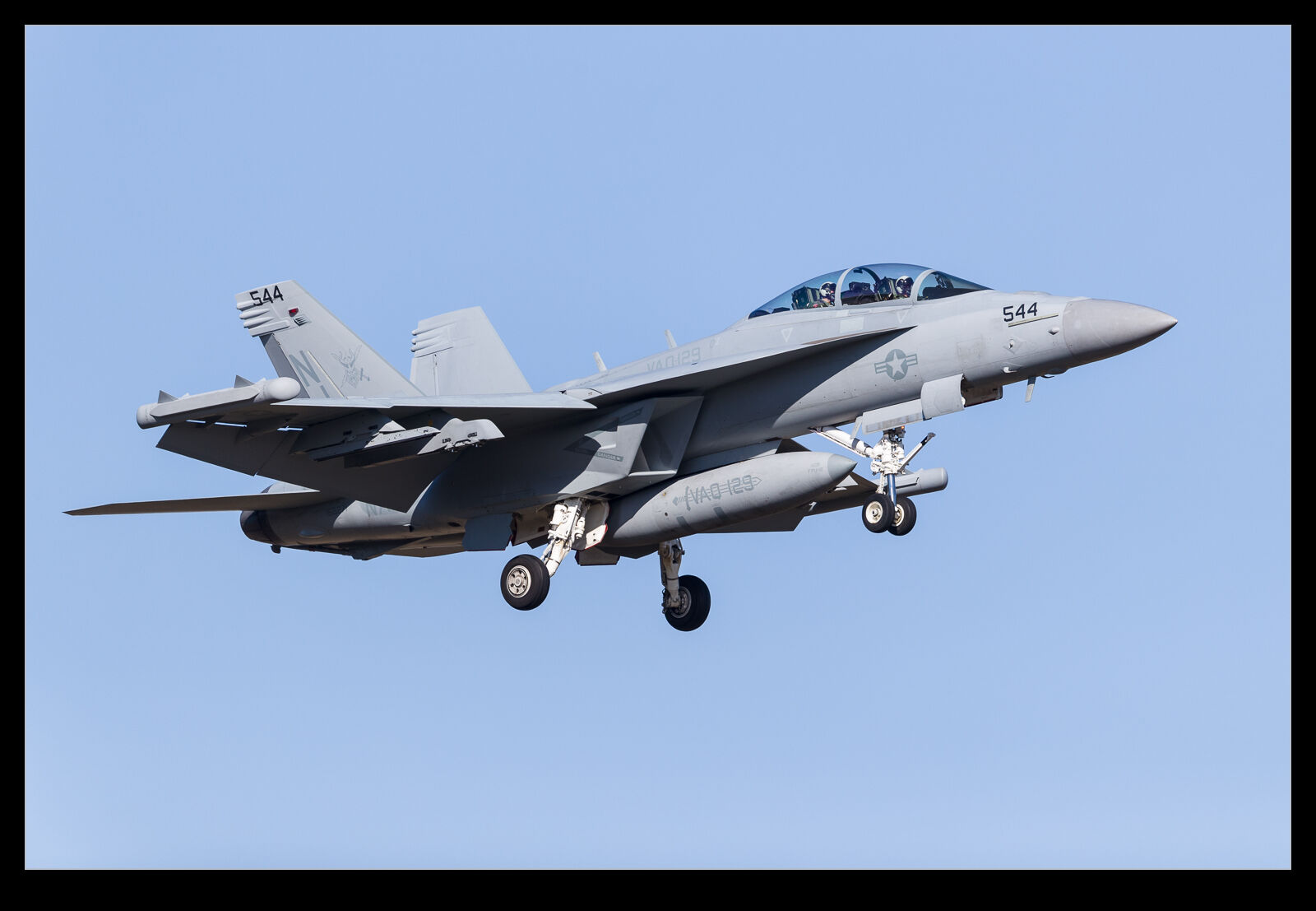 NAS Whidbey Island has its outlying field at Coupeville. They announce when flying training will take place there in order to keep the local community aware of the potential noise. Usually there is little chance for me to go because of work but it turned out that one of the flying days was scheduled to have good weather and I should be able to take time off. Not only was the weather due to be good but the wind was in a direction that meant they would be flying to the end of the runway that is more accessible. I planned to be there.
NAS Whidbey Island has its outlying field at Coupeville. They announce when flying training will take place there in order to keep the local community aware of the potential noise. Usually there is little chance for me to go because of work but it turned out that one of the flying days was scheduled to have good weather and I should be able to take time off. Not only was the weather due to be good but the wind was in a direction that meant they would be flying to the end of the runway that is more accessible. I planned to be there.
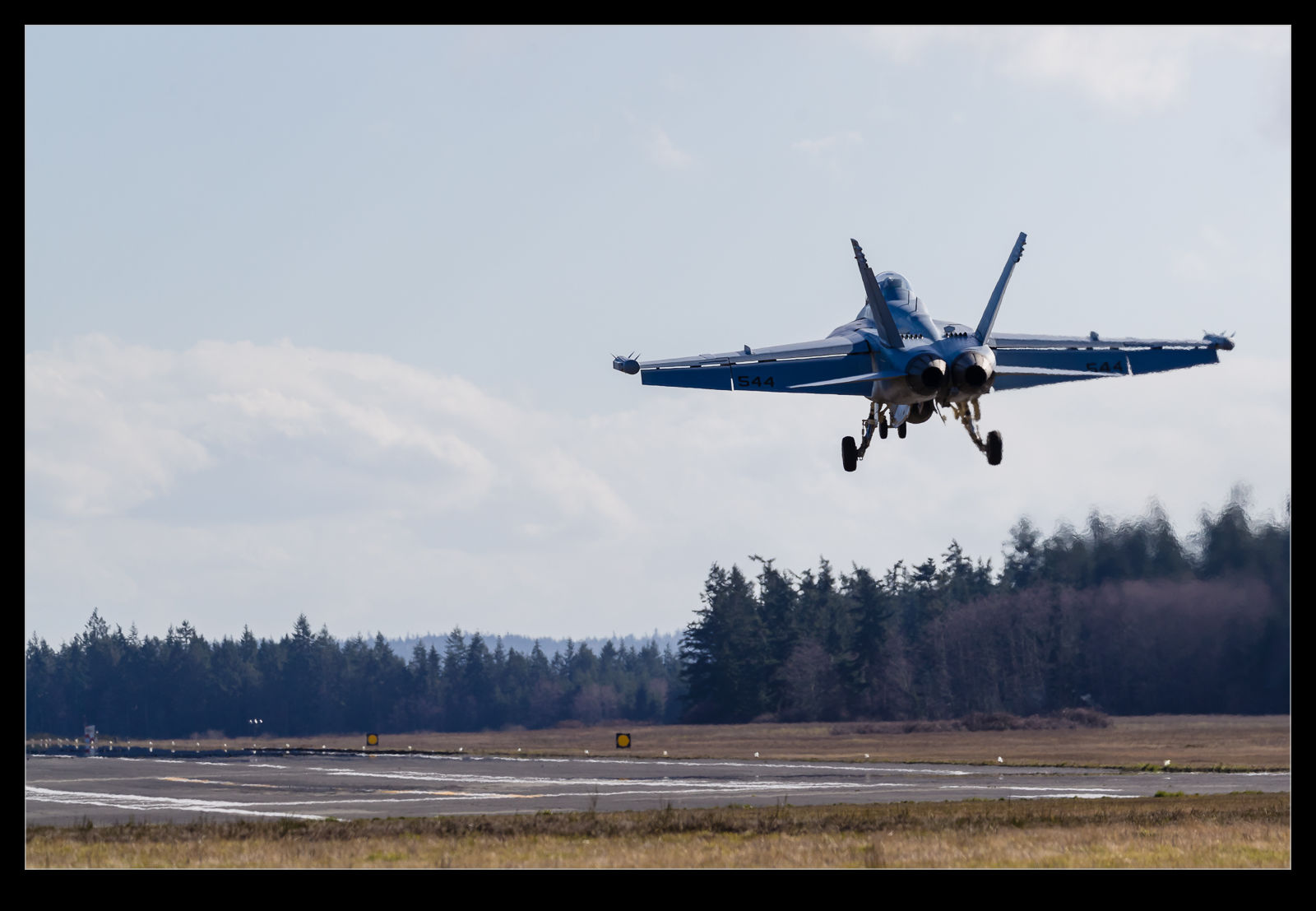 As it happened, something came up at work and I had to go to Seattle before I could leave. Consequently, I was behind schedule. I eventually managed to get on my way and I got to Mukilteo just in time to catch a ferry. Once on the island, I headed up to Coupeville and, sure enough, as I got closer, I could see Growlers flying patterns. I got to the field and parked up away from the road. I walked back, all the time hearing jets flying around. Then I was in position to get some shots.
As it happened, something came up at work and I had to go to Seattle before I could leave. Consequently, I was behind schedule. I eventually managed to get on my way and I got to Mukilteo just in time to catch a ferry. Once on the island, I headed up to Coupeville and, sure enough, as I got closer, I could see Growlers flying patterns. I got to the field and parked up away from the road. I walked back, all the time hearing jets flying around. Then I was in position to get some shots.
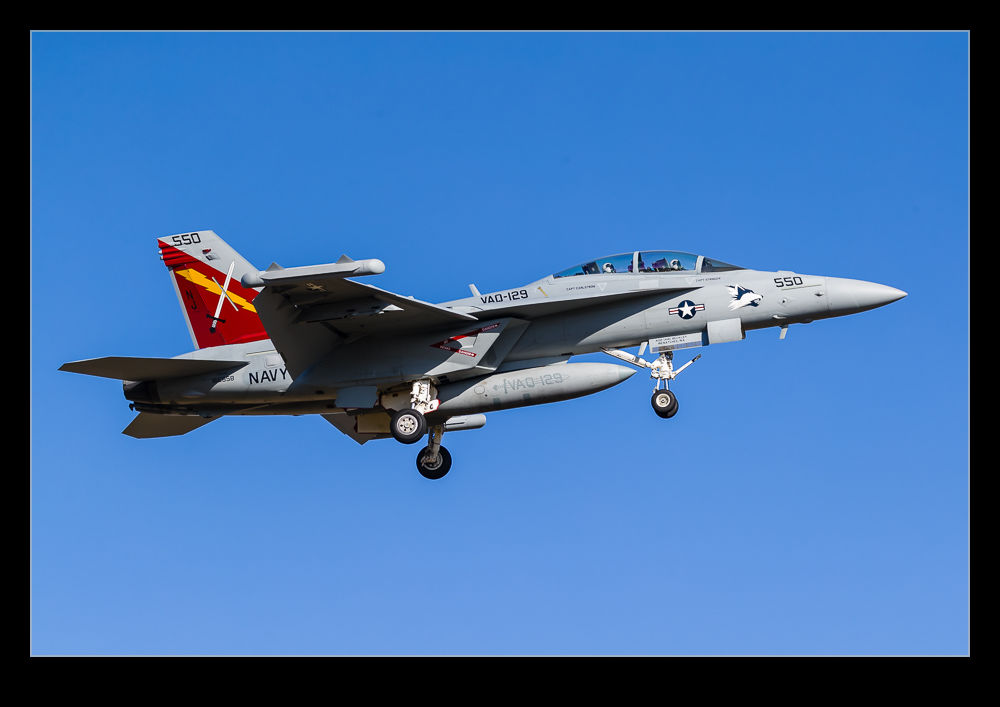 I kept moving so I could get closer to the touchdown point but the flying stopped as I got closer. Then they packed up operations. They were done, at least until the evening. If I had missed the boat, I would have missed the whole thing!
I kept moving so I could get closer to the touchdown point but the flying stopped as I got closer. Then they packed up operations. They were done, at least until the evening. If I had missed the boat, I would have missed the whole thing!
Salty Dog Hornet Goes Tanking
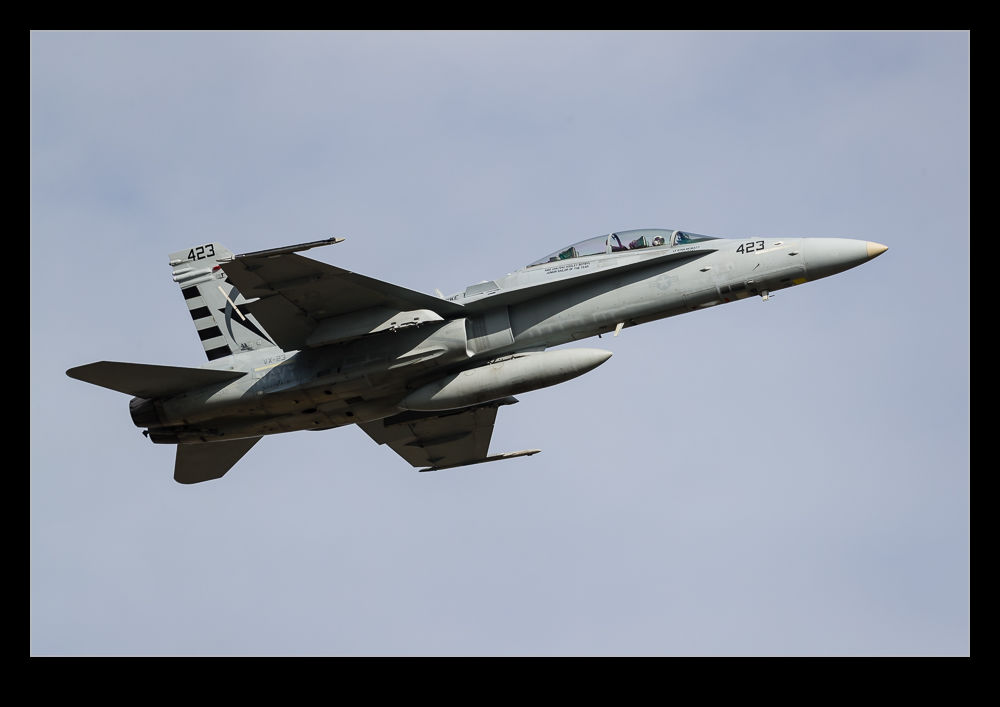 The never-ending test program for the KC-46 Pegasus involves testing with a variety of receiver aircraft. Recently, the Navy has deployed jets to Boeing Field to work with the tankers. While I was there, it was a Boeing F/A-18D Hornet that was sent across. Operating with the call-sign, Salty Dog, the Hornet blasted out of the field ahead of its tanker. They were scheduled to be up until after dark so I didn’t hang around for their return.
The never-ending test program for the KC-46 Pegasus involves testing with a variety of receiver aircraft. Recently, the Navy has deployed jets to Boeing Field to work with the tankers. While I was there, it was a Boeing F/A-18D Hornet that was sent across. Operating with the call-sign, Salty Dog, the Hornet blasted out of the field ahead of its tanker. They were scheduled to be up until after dark so I didn’t hang around for their return.
Finally, We Get What We Came For
 As my day at the canyon continued (you can read about the beginnings here), I got a bit more luck. The Navy came to the rescue with some Hornets and Super Hornets making their way through the canyon. One came in at an odd angle and then pulled out of the canyon over the overlook location. This was fine for me but probably annoyed those further down the canyon.
As my day at the canyon continued (you can read about the beginnings here), I got a bit more luck. The Navy came to the rescue with some Hornets and Super Hornets making their way through the canyon. One came in at an odd angle and then pulled out of the canyon over the overlook location. This was fine for me but probably annoyed those further down the canyon.
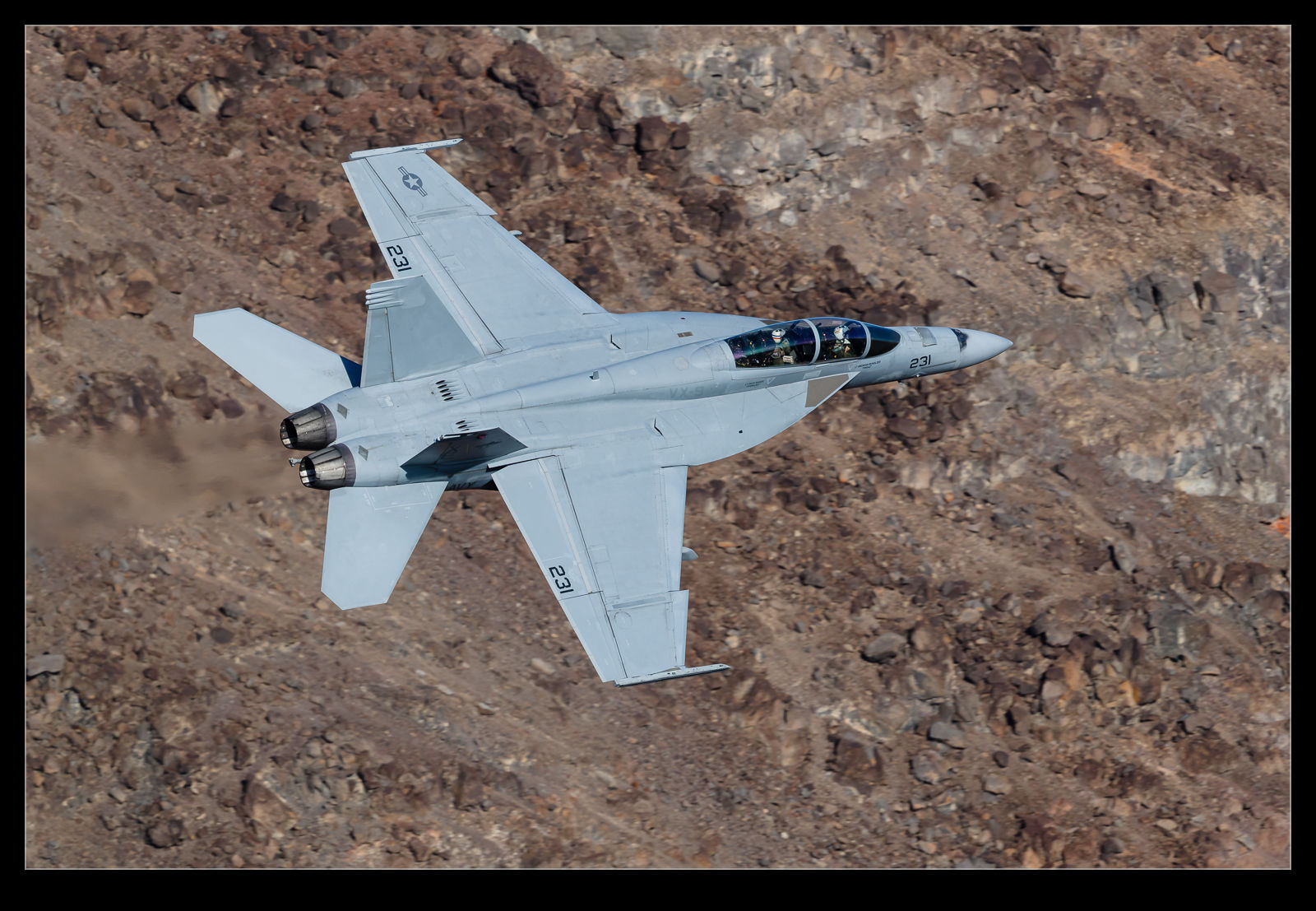 Then we got something a lot more like what we had anticipated. Jets came in along the angle from the highway starting out a lot lower than those that had come across the ridge. They could drop in a lot more quickly and be deeper into the canyon as they came by. This was what it was all about. They provided a last minute contribution to what I had come for and I was very grateful. A few more would have been good but it was okay.
Then we got something a lot more like what we had anticipated. Jets came in along the angle from the highway starting out a lot lower than those that had come across the ridge. They could drop in a lot more quickly and be deeper into the canyon as they came by. This was what it was all about. They provided a last minute contribution to what I had come for and I was very grateful. A few more would have been good but it was okay.
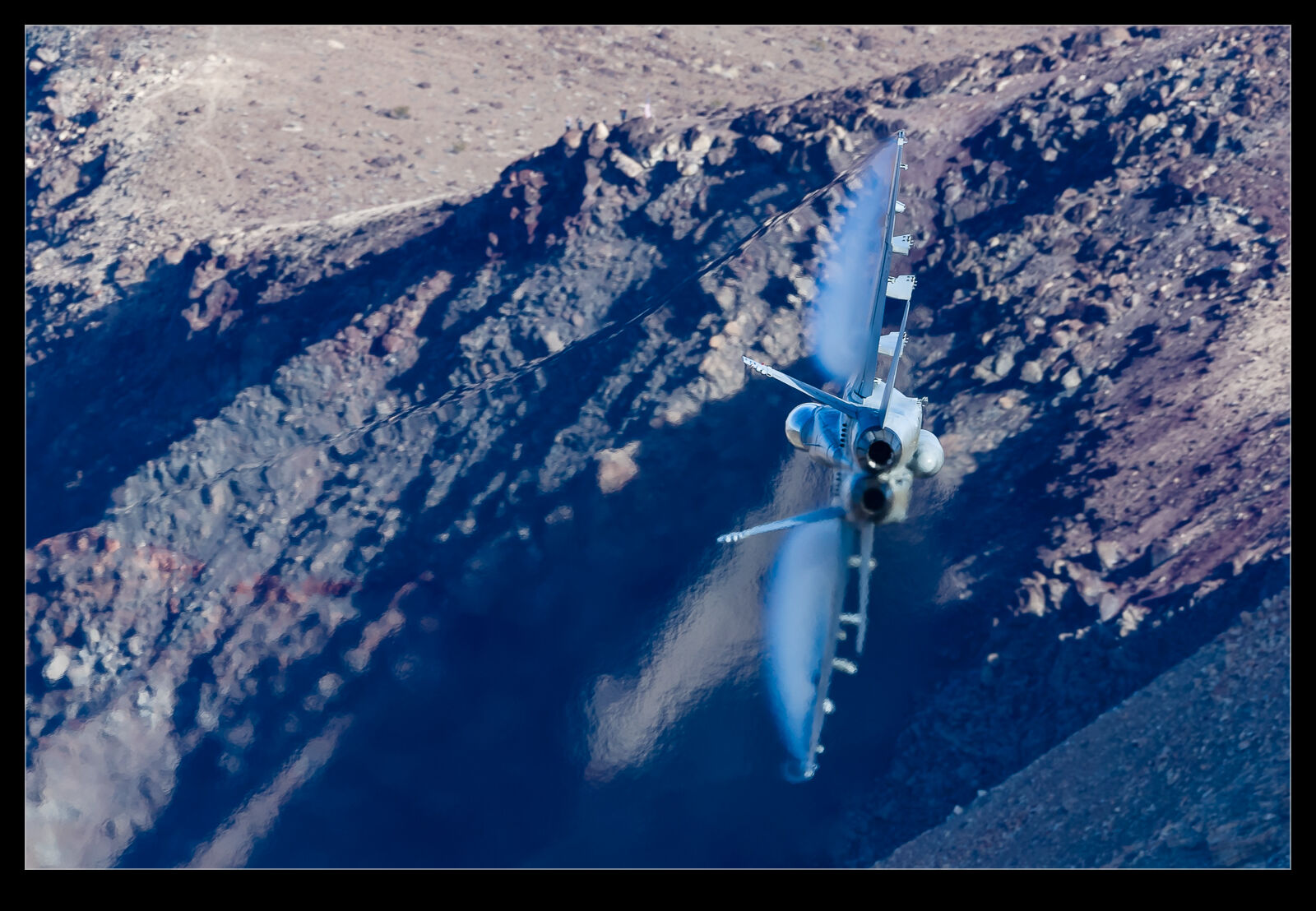 Once disappointing aspect of this was that, with so few jets coming through, I shot all of them. I didn’t have the opportunity to waste so I never got to keep the camera down and just appreciate the jets transitioning through below me for what it was. On my next trip I will hopefully get to do that as well as get some shots.
Once disappointing aspect of this was that, with so few jets coming through, I shot all of them. I didn’t have the opportunity to waste so I never got to keep the camera down and just appreciate the jets transitioning through below me for what it was. On my next trip I will hopefully get to do that as well as get some shots.
- A US Navy Boeing F/A-18E Super Hornet flies through the Sidewinder transition in Death Valley CA.
- A US Navy Boeing F/A-18F Super Hornet flies through the Sidewinder transition in Death Valley CA.
- A US Navy Boeing F/A-18F Super Hornet flies through the Sidewinder transition in Death Valley CA.
P-8 in the Wild
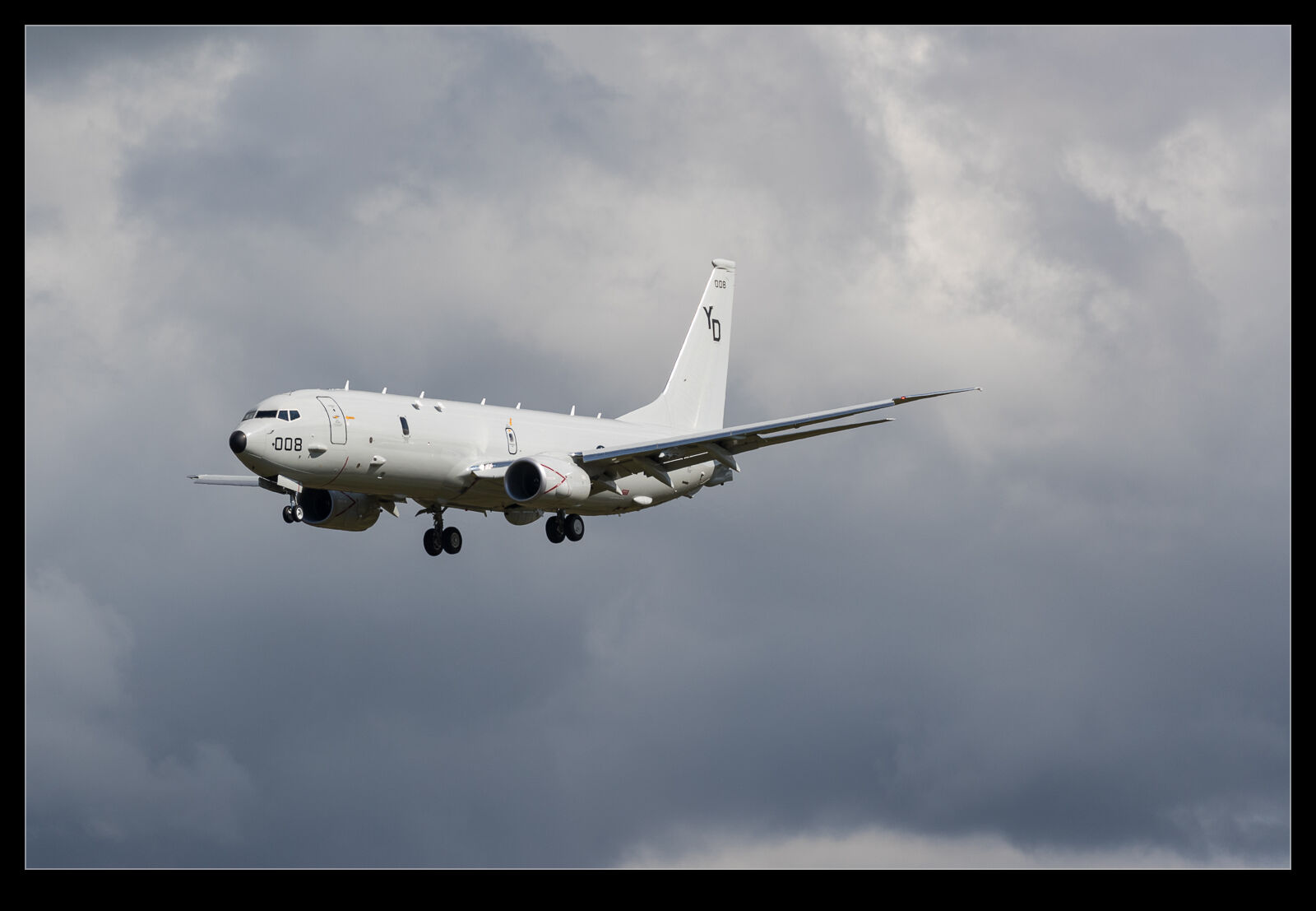 Despite the number of them that are now in service, I have very little experience with the Boeing P-8 Poseidon. I had only seen one flying and that was a test jet at Boeing Field. When we got to NAS Whidbey Island, the P-3s were the thing I was more interested in but I certainly wasn’t going to turn down an operational P-8 for the first time. It didn’t take long to get one. We had not long arrived when one departed past us on the shoreline.
Despite the number of them that are now in service, I have very little experience with the Boeing P-8 Poseidon. I had only seen one flying and that was a test jet at Boeing Field. When we got to NAS Whidbey Island, the P-3s were the thing I was more interested in but I certainly wasn’t going to turn down an operational P-8 for the first time. It didn’t take long to get one. We had not long arrived when one departed past us on the shoreline.
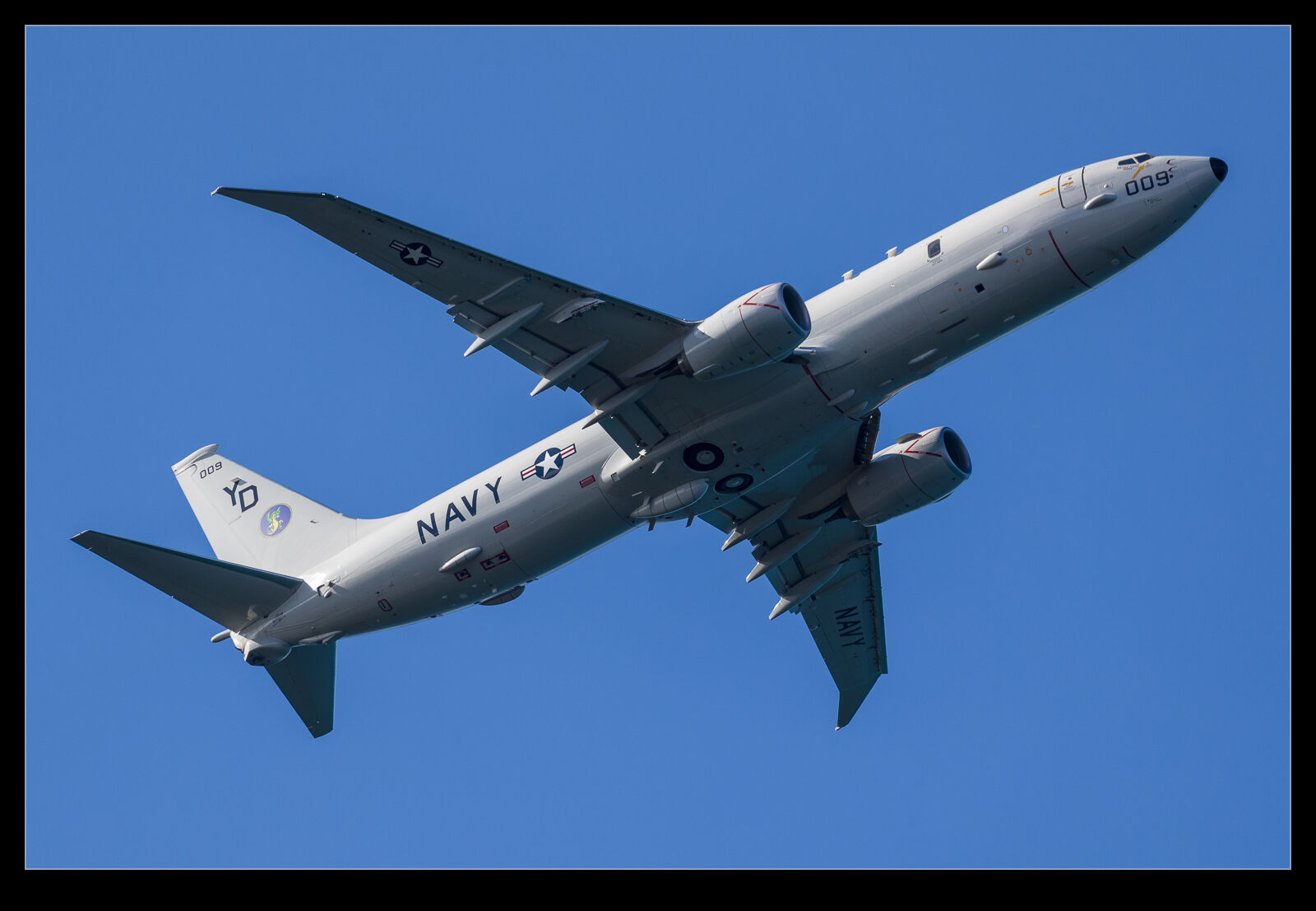 As we moved around for the arrivals, we got a bit more P-8 traffic. Some arrivals showed up. One was lacking in anything colorful for squadron markings but another included a bit more individuality. I wonder whether we shall gradually see more color showing up on the jets or whether they shall be a fleet of bland, gray jets. Fingers crossed!
As we moved around for the arrivals, we got a bit more P-8 traffic. Some arrivals showed up. One was lacking in anything colorful for squadron markings but another included a bit more individuality. I wonder whether we shall gradually see more color showing up on the jets or whether they shall be a fleet of bland, gray jets. Fingers crossed!
CAG Growlers
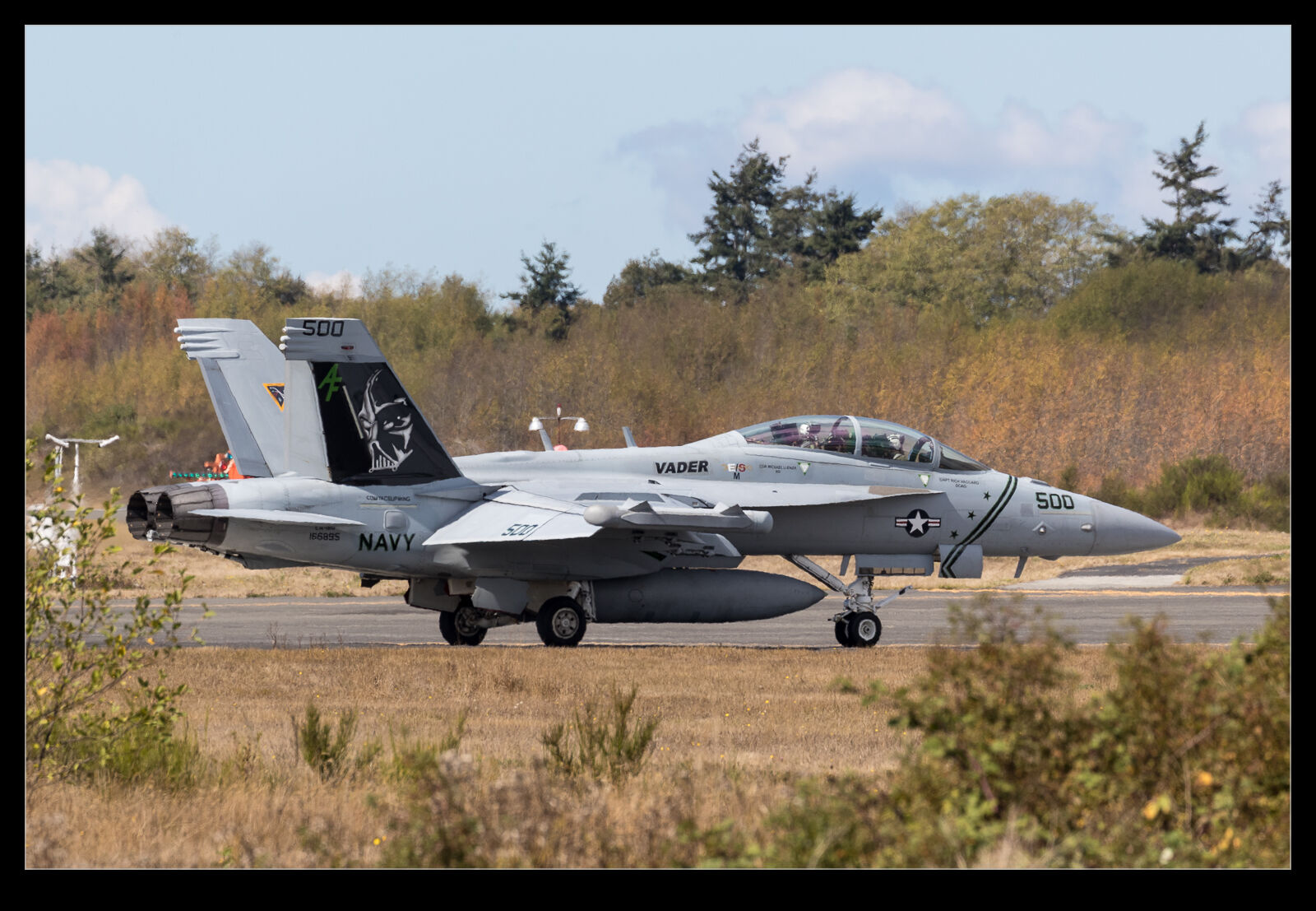 NAS Whidbey Island is the home for all of the Growlers in the fleet. It is a fair chance that you will get a bit of Growler activity on a visit and we were not disappointed. What was really pleasing was to see a bunch of the CAG aircraft in action. The first glimpses were as they taxied out for departure and you could see the planes coming up the taxiway. Unfortunately, the heat haze was a bit of a problem while they were on the ground.
NAS Whidbey Island is the home for all of the Growlers in the fleet. It is a fair chance that you will get a bit of Growler activity on a visit and we were not disappointed. What was really pleasing was to see a bunch of the CAG aircraft in action. The first glimpses were as they taxied out for departure and you could see the planes coming up the taxiway. Unfortunately, the heat haze was a bit of a problem while they were on the ground.
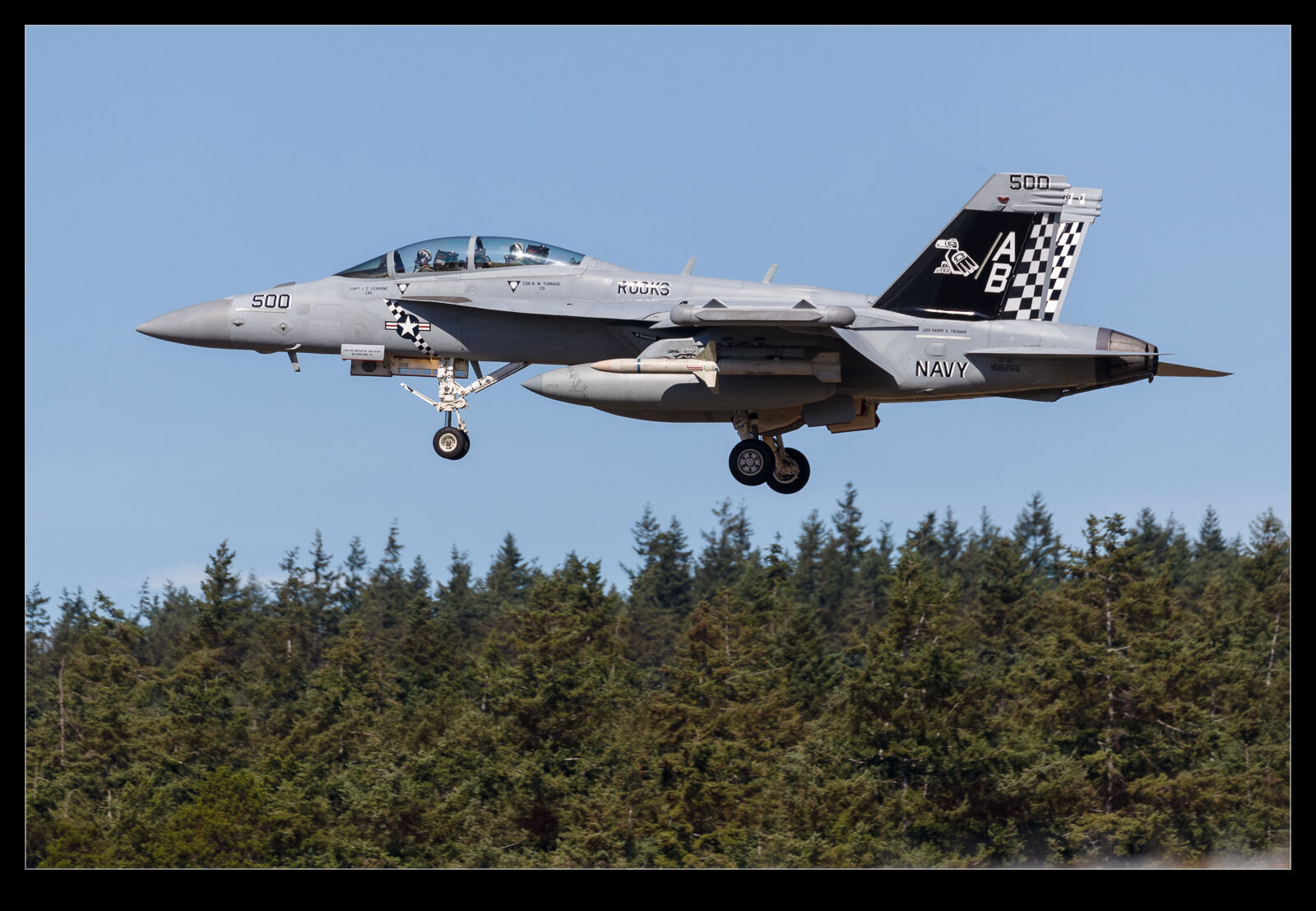 Naturally, if they were launching, they were likely to be coming back at some point. Sure enough, we got them come into the overhead and down the approach. Even when airborne, the heat haze was a bit of a problem. Better than on the ground but still an issue. In a time of gray jets, it is certainly welcome to get something a bit more colorful, even if for some of them that is only black and white.
Naturally, if they were launching, they were likely to be coming back at some point. Sure enough, we got them come into the overhead and down the approach. Even when airborne, the heat haze was a bit of a problem. Better than on the ground but still an issue. In a time of gray jets, it is certainly welcome to get something a bit more colorful, even if for some of them that is only black and white.
P-3s May Be Going But There Are Still Some
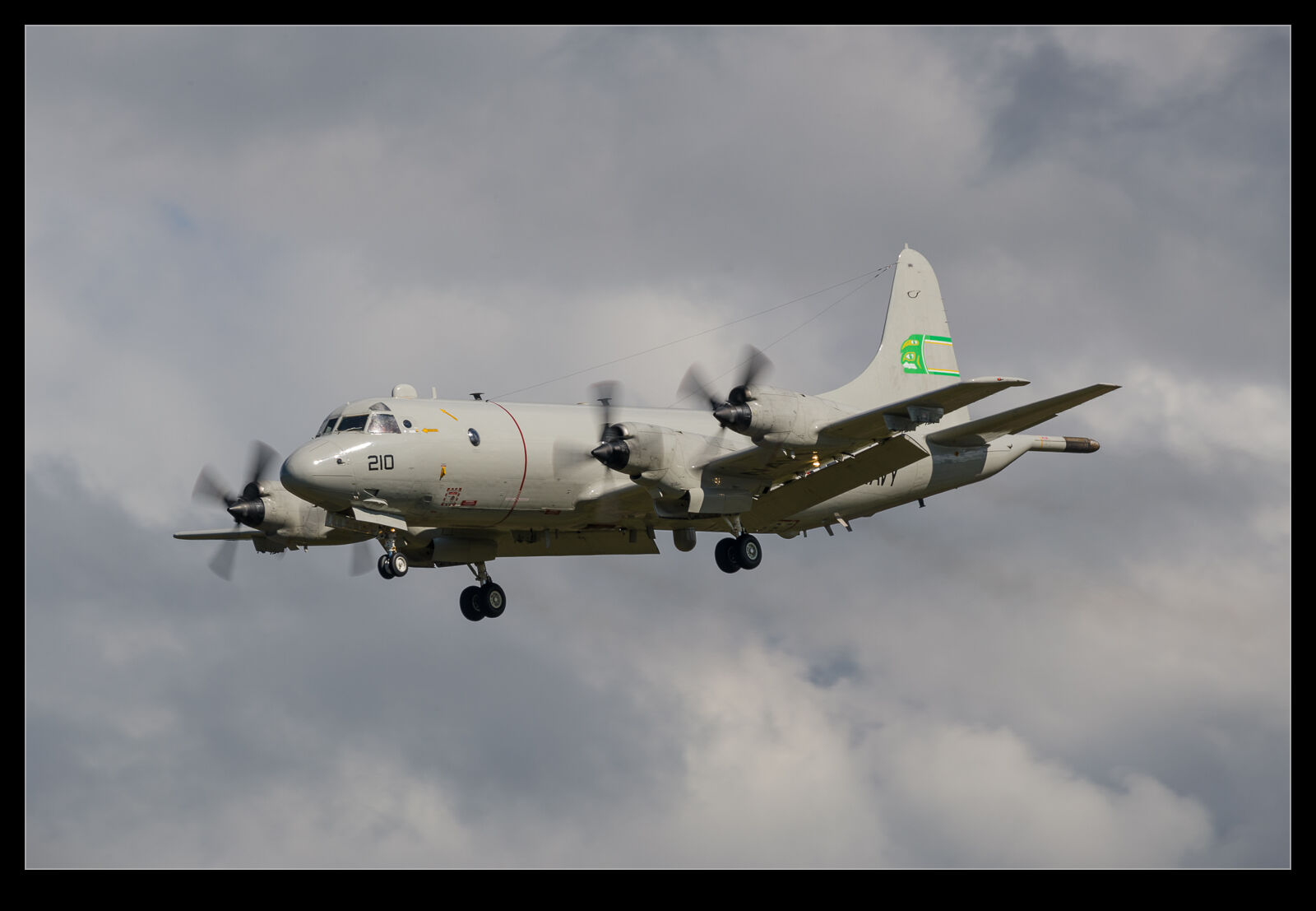 A trip to Whidbey Island for me and Paul was aimed at seeing whatever we could get there on a random weekday. In truth, though, what we really wanted was P-3s. With the Orions rapidly being replaced by P-8s, they are getting harder to find and will soon be a memory. Consequently, our fingers were crossed for some of Lockheed’s aging subhunters. It turned out we were lucky.
A trip to Whidbey Island for me and Paul was aimed at seeing whatever we could get there on a random weekday. In truth, though, what we really wanted was P-3s. With the Orions rapidly being replaced by P-8s, they are getting harder to find and will soon be a memory. Consequently, our fingers were crossed for some of Lockheed’s aging subhunters. It turned out we were lucky.
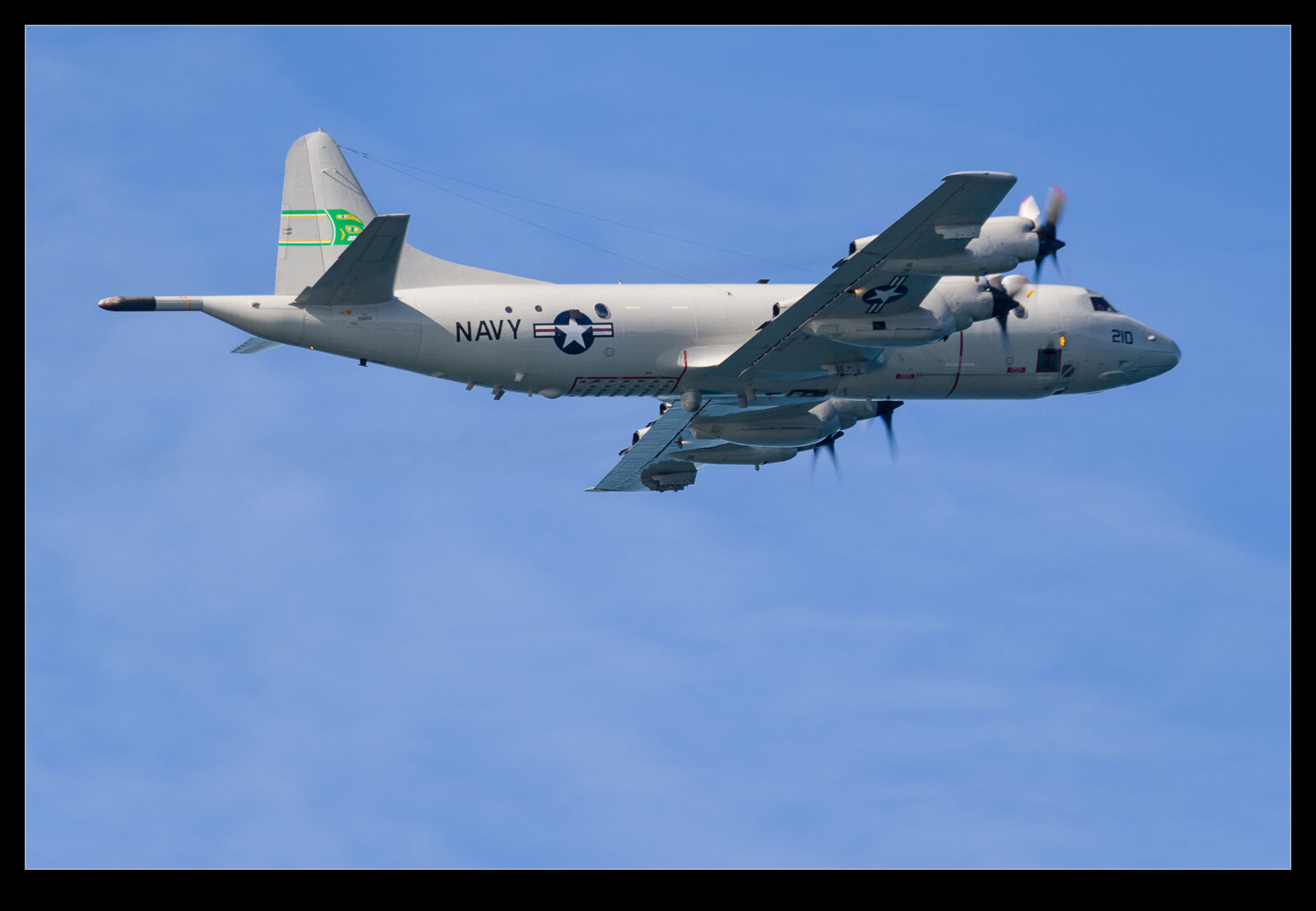 It wasn’t a busy day for the turboprops but we did get to see a few. A departure early on meant we were pleased to have had some success. We also got arrival traffic later which certainly was pleasing. Our only disappointment was that one of the planes was operating with a rare canoe under the fuselage. We saw it in the distance (when the shots are horribly distorted by heat haze) but it was operating off a different runway from that which we were near, and we never were in the right place. However, we did get some of its buddies so a successful day out.
It wasn’t a busy day for the turboprops but we did get to see a few. A departure early on meant we were pleased to have had some success. We also got arrival traffic later which certainly was pleasing. Our only disappointment was that one of the planes was operating with a rare canoe under the fuselage. We saw it in the distance (when the shots are horribly distorted by heat haze) but it was operating off a different runway from that which we were near, and we never were in the right place. However, we did get some of its buddies so a successful day out.
If You Can’t See Where You Are Going, It Is Your Fault!
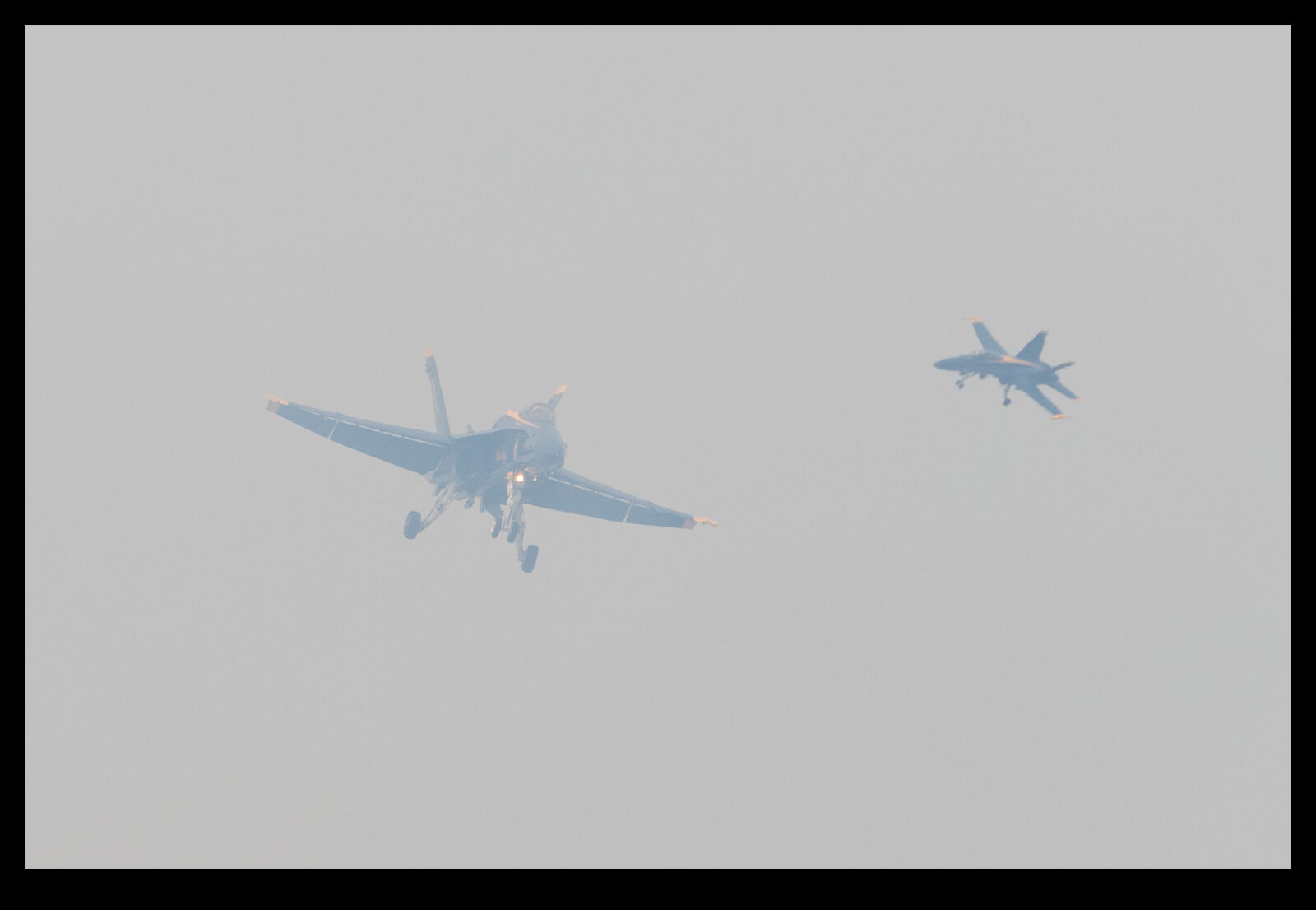 We relocated to the other end of Boeing Field for the return of the Blue Angels. They ran in across the field trailing white smoke. Unfortunately, with little wind, this meant a pall of smoke was now hanging over the airport. As they broke into the downwind and then turned onto final, it was sometimes hard to see them at all. A healthy boosting of the contrast makes some of the shots a bit more visible but, in truth, the viz was really awful. I only hope they had a slightly better view of the ground than we had of them since their being able to see was slightly more important.
We relocated to the other end of Boeing Field for the return of the Blue Angels. They ran in across the field trailing white smoke. Unfortunately, with little wind, this meant a pall of smoke was now hanging over the airport. As they broke into the downwind and then turned onto final, it was sometimes hard to see them at all. A healthy boosting of the contrast makes some of the shots a bit more visible but, in truth, the viz was really awful. I only hope they had a slightly better view of the ground than we had of them since their being able to see was slightly more important.
T-45 Nose Gear Door Sequencing
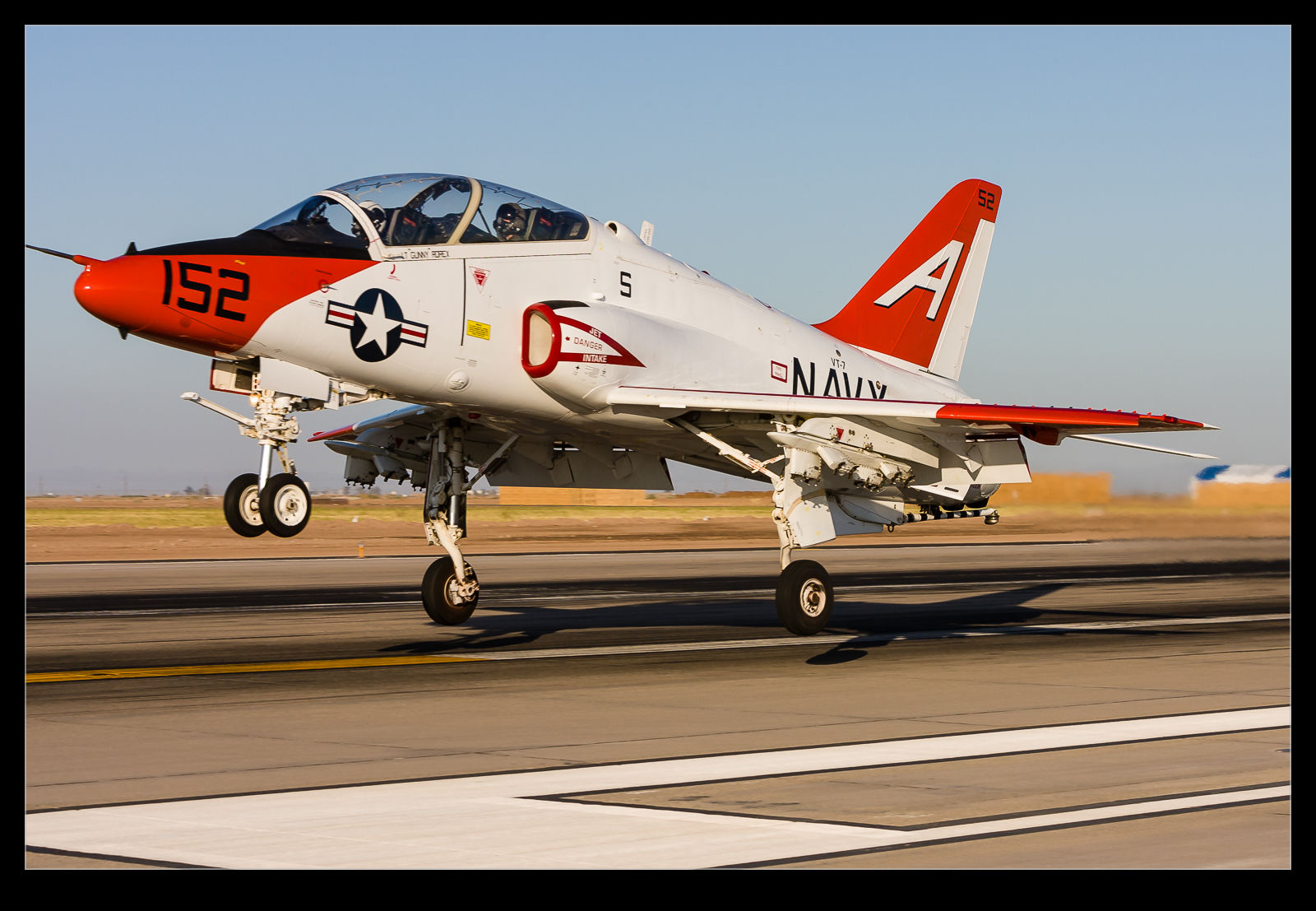 With a title like that, who could resist reading this one! The T-45 is a plane I have a close affinity with. It was my involvement with the project that first brought me to work in the US and it is responsible for me meeting Nancy. Aside from that, I got quite involved in many aspects of the plane’s design so feel like I know it quite well. It did not have a smooth entry to service and went through a multitude of upgrades prior to being accepted in to service. One of the lesser known items was the nose gear doors.
With a title like that, who could resist reading this one! The T-45 is a plane I have a close affinity with. It was my involvement with the project that first brought me to work in the US and it is responsible for me meeting Nancy. Aside from that, I got quite involved in many aspects of the plane’s design so feel like I know it quite well. It did not have a smooth entry to service and went through a multitude of upgrades prior to being accepted in to service. One of the lesser known items was the nose gear doors.
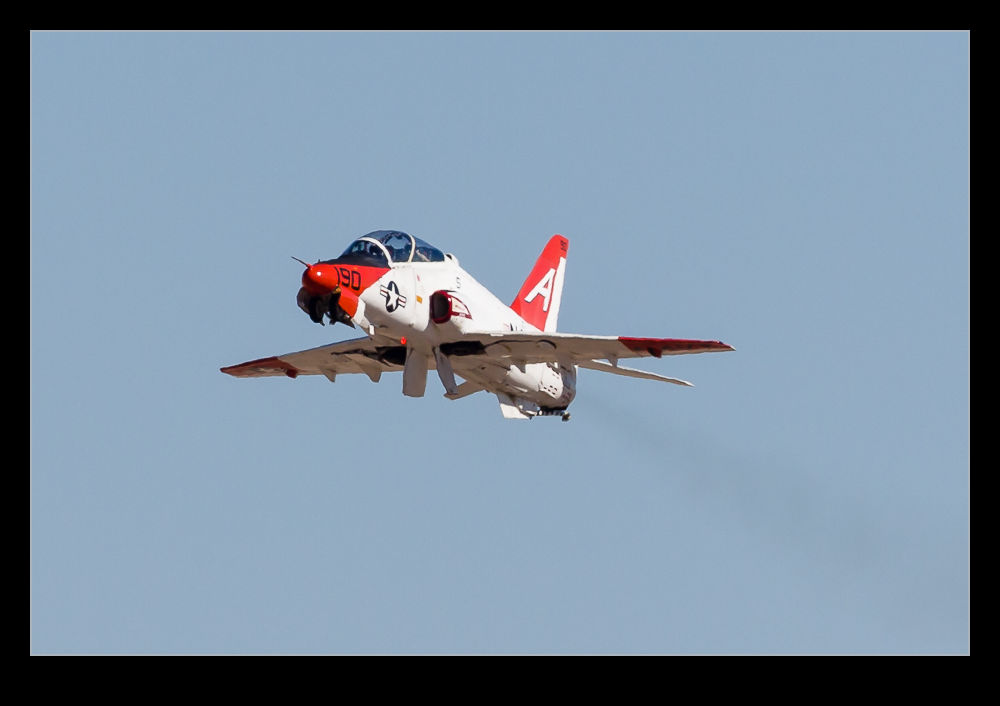 These were lumped in to a bunch of issues relating to directional stability. The front fuselage of the T-45 is considerably deeper than the original Hawk but the design originally had the same fin and actually lost the ventral fins that were either side of the airbrake on the original. Directional control was enhanced by adding a fin cap, modifying the rudder design and adding a new ventral fin on the arrestor hook fairing. One other change was made too.
These were lumped in to a bunch of issues relating to directional stability. The front fuselage of the T-45 is considerably deeper than the original Hawk but the design originally had the same fin and actually lost the ventral fins that were either side of the airbrake on the original. Directional control was enhanced by adding a fin cap, modifying the rudder design and adding a new ventral fin on the arrestor hook fairing. One other change was made too.
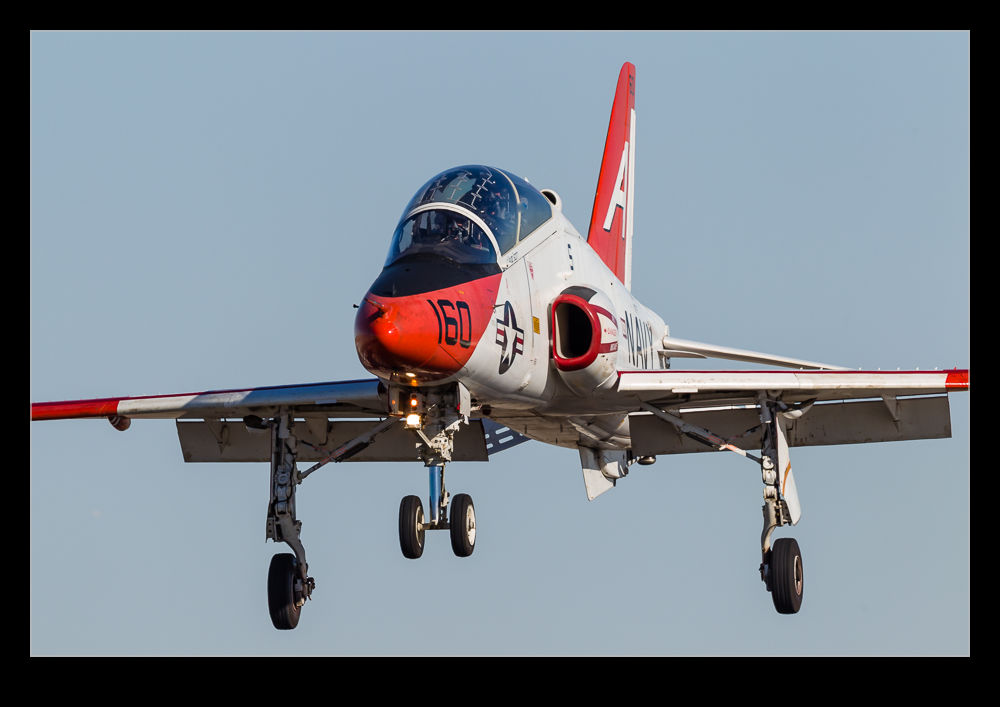 The carrier launch requirements meant the simple nose gear was replaced with a far chunkier assembly with dual wheels and the catapult launch bar, all of which was beefier enough to take the catapult launch loads. Covering this all up were big nose gear doors. These were originally either open or closed. If you look at the doors, you can see they are like adding large fins to the front fuselage. This is very destabilizing. The rear doors must stay open when the gear is down but the front doors were rescheduled to close again once the gear was down, making a substantial difference in directional stability. They have to open while the gear is transitioning and stability is reduced during this phase but it doesn’t last long. However, if you watch the retraction and extension sequence, you get a brief glimpse at how big these doors really are. From what I understand, a similar issue affected the F-35 and only the first airframe, AA-1, had the old single huge gear door.
The carrier launch requirements meant the simple nose gear was replaced with a far chunkier assembly with dual wheels and the catapult launch bar, all of which was beefier enough to take the catapult launch loads. Covering this all up were big nose gear doors. These were originally either open or closed. If you look at the doors, you can see they are like adding large fins to the front fuselage. This is very destabilizing. The rear doors must stay open when the gear is down but the front doors were rescheduled to close again once the gear was down, making a substantial difference in directional stability. They have to open while the gear is transitioning and stability is reduced during this phase but it doesn’t last long. However, if you watch the retraction and extension sequence, you get a brief glimpse at how big these doors really are. From what I understand, a similar issue affected the F-35 and only the first airframe, AA-1, had the old single huge gear door.
